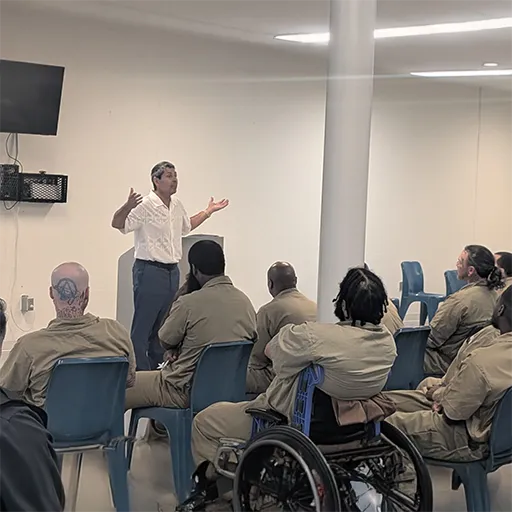USP Canaan

Early in my prison journey, I remember being inspired by a quote from Zig Ziglar, the author and corporate trainer: “You can have everything in life you want, if you will just help enough other people get what they want.”
That mindset has guided my work for decades, and it framed the way I approached my visit to USP Canaan, one of the most volatile high-security federal prisons in the nation. I always look forward to entering prisons like Canaan. Why? Because I am confident the programs we create can make a real difference in helping people inside—and society at large—get what they want.
- Citizens want safer communities.
- Prison administrators and staff want their institutions to run efficiently, without violence.
- People serving time want opportunities to improve their lives and prepare for success after release.
When people in prison start investing in themselves—developing skills, building discipline, and working toward lives of meaning, relevance, and dignity—positive change follows. Fewer disruptions. Better culture. More opportunities for excellence. And ultimately, lower recidivism rates and safer communities for everyone.

Gratitude for USP Canaan Leadership
I am grateful to Warden Fernando Garza and his leadership team for welcoming me and authorizing this visit. It takes courage and vision for administrators to open their doors to outside programs and perspectives.
At 8:00 a.m., Carole and I met with Ms. Kristen Castrati and the Associate Wardens, who walked us into Warden Garza’s conference room. I expressed my gratitude for their leadership and the opportunity to contribute.
Our nonprofit’s mission depends on persuading more people in prison to take responsibility for building self-directed release plans. We provide all resources at no cost to the Bureau of Prisons or to those serving time—but there’s a condition: individuals must memorialize their efforts to prepare for law-abiding, contributing lives. At USP Canaan, I wanted to show how this model could help the institution, staff, and people in custody all succeed together.

Speaking at USP Canaan
The Executive Staff then escorted us into a large auditorium, where approximately 100 men had gathered. Many of these men are serving multiple life sentences.
I shook hands with as many as I could and shared stories of people I’ve known who once faced similar sentences but are now free, living meaningful lives in society. What made the difference for them wasn’t luck—it was their decision to start investing in themselves, to build a body of work that set them apart and showed their commitment to reconciliation.
The men at Canaan engaged deeply. They asked thoughtful questions, pledged to participate, and showed me they were ready to invest in themselves. I reminded them that while I work on reforms at a systemic level, their role is critical. They can help by lowering levels of violence inside Canaan and by building records of personal accountability that prove they are ready for better outcomes.

Moving Forward
I left USP Canaan inspired. The willingness of Warden Garza and his team to embrace new approaches—and the openness of the men to commit to personal growth—showed me that even in one of the most challenging environments, change is possible.
I look forward to seeing how the men of Canaan follow through on their pledges and how this partnership can lead to measurable improvements in culture, safety, and long-term outcomes.
Together, by aligning the goals of citizens, administrators, staff, and people in prison, we can build safer communities and open new pathways to excellence. I am especially grateful to Warden Garza and his entire team for leading by example, showing that when administrators embrace education and reform, they create opportunities for safer, stronger outcomes for everyone.
